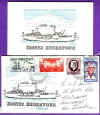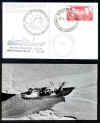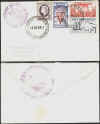HOME > STAMP SITES > New Zealand Antarctic Covers > the 1960s
HOME > STAMP SITES > New Zealand Antarctic Covers > the 1960s
The year 1960 saw the end of RNZAF Beaver (NZ6001 later 6010)and Auster (NZ 1707) operations. The DHC 2 Beaver use ended with the aircraft crashing on the Beardmore Glacier on January 15th 1960 being caught in a descending ceiling. It was a write-off. There were no fatalities. Antarctic flying has had a high toll on aircraft. The Beaver was bought by public subscription and named City of Auckland. There are Beavers in New Zealand, replicating the appearance of this aircraft, but they are not the original aircraft. See Kiwi Beavers for more on the NZ use of these aircraft. The aircraft operated from Scott Airstrip on the Ross Shelf ice adjacent to Scott Base, with a small hangar. They over wintered there. The Auster had limited lifting capacity and only ever made one landing on the Polar Plateau. The RNZAF also owned and operated an ex RAF TAE (later USN) Otter with the intent of using it in Antarctica but this never eventuated. The USN stored it at McMurdo and that was where the RNZAF bought it, but it was shipped it back to New Zealand without ever flying there under NZ ownership.
The 1959-60 voyage of Endeavour has been recounted by Ian Bradley. 2004, Don't Rock the Boat, Privately published, Auckland. He was her navigating officer.
1960-61 was the last trip by Endeavour I |
|||||||||||||||||||||||||||||||
 Hut
Restoration Project cachet Hut
Restoration Project cachet
|
|||||||||||||||||||||||||||||||
 1959-60
souvenir cover, Hillary pic. 1959-60
souvenir cover, Hillary pic.
|
|||||||||||||||||||||||||||||||
 Endeavour
cover Endeavour
cover
|
|||||||||||||||||||||||||||||||
|
|
All cover illustrations are thumbnails |
||||||||||||||||||||||||||||||
|
1961
|
|||||||||||||||||||||||||||||||
|
|
All cover illustrations are thumbnails |
||||||||||||||||||||||||||||||
|
1962
In June 1962, US navy oiler Namakagon was lent to NZ. She went through a refit first and was strengthened for service in ice. Commissioned into the RNZN in October 1962 as HMNZS Endeavour II. See stamp. Endeavour served as Antarctic support ship until the end of the 1970/71 season and was returned to the US in June 1971. |
|||||||||||||||||||||||||||||||
 62/63
cachet 62/63
cachet
|
|||||||||||||||||||||||||||||||
Huts of the Heroic AgeModern practice has been to use the ship names as a name for the expedition though they were not originally so named.
Cape Adare is at the entrance to the Ross Sea on the Antarctic mainland. Cape Evans and Cape Royds are further north on Ross Island. Other expeditions of this time did not over-winter so did not have huts. Antarctic Heritage Trust Historic Huts page
Two heroic age ships are preserved, Fram at Oslo and Discovery at Dundee
Scott Base is near to Scott's 1902 "Discovery Hut". It is next to the US McMurdo base, on the far side of that base from Scott Base.
Hut RestorationThere are several covers with hut restoration cachets right up to the present. In a high stress environment with structures never originally intended to last more than a few years, this task is never-ending and continues today.
|
|||||||||||||||||||||||||||||||
 62/63
cachet 62/63
cachet
|
|||||||||||||||||||||||||||||||
 Illustrated cover
Illustrated cover
|
|||||||||||||||||||||||||||||||
 Scott
50 years cancellation Scott
50 years cancellation
|
|||||||||||||||||||||||||||||||
 Ditto
Ditto
|
|||||||||||||||||||||||||||||||
 Victoria
University cachet, 1962/63 cachet Victoria
University cachet, 1962/63 cachet
|
|||||||||||||||||||||||||||||||
 Endeavour,
Antarctic Flight and USS Burton Island Cachets. Endeavour,
Antarctic Flight and USS Burton Island Cachets.
|
|||||||||||||||||||||||||||||||
|
|
All cover illustrations are thumbnails |
||||||||||||||||||||||||||||||
|
1963 The vice-regal visit was commemorated by a special cancel and pre-printed covers. 'Vice-regal' refers to New Zealand's governor general - the monarch's representative in New Zealand, who performs the same constitutional role in New Zealand's governance as the British Monarch does in Britain. The British Queen is officially the Queen of New Zealand but it is not practical for her to perform the role in absentia. The GG appointment is for a term and is made by the Queen on the nomination of the New Zealand government. The GG of the time was Brigadier Sir Bernard Fergusson. He was the last British born GG. After him Governments have preferred New Zealand born appointees. The penguins of the Ross Sea are Adelie and Emperor penguins.
Both appear on many stamps, including these from the 2001set.
Emperors have an extraordinary breeding cycle. The eggs are tended over winter by the males who eat nothing in that time. They cluster together to break the wind. The females return when the eggs hatch and both sexes feed the chicks. The chicks become independent about the time the sea ice breaks up allowing them immediate access to the sea. Road to Scott Base Until 1963 the route to Scott Base from the McMurdo base was over a sea ice road. However a sea ice breakout left over-land as the only route. A road was started in 1963/64 and completed in 1966.
|
|||||||||||||||||||||||||||||||
 Endeavour
maiden voyage pre-printed cover Endeavour
maiden voyage pre-printed cover
|
|||||||||||||||||||||||||||||||
 Another Another
|
|||||||||||||||||||||||||||||||
 Pre-printed
cover for visit Pre-printed
cover for visit
|
|||||||||||||||||||||||||||||||
 Another Another
|
|||||||||||||||||||||||||||||||

|
|||||||||||||||||||||||||||||||
|
|
|||||||||||||||||||||||||||||||
 New
Endeavour cover New
Endeavour cover
|
|||||||||||||||||||||||||||||||
|
|
|||||||||||||||||||||||||||||||
|
|
All cover illustrations are thumbnails |
||||||||||||||||||||||||||||||
|
1964 Dry
Valleys Rivers can form in the warmest part of the year. The lakes that some flow into can remain frozen at the surface.
The saline bottom water in Lake Vanda traps solar energy and is well above freezing. Ice in such lakes can melt from the bottom as the water is warmed by radiation passing through the ice.
The dry valleys have other interesting features including patterned ground, sand dunes, ventifacts and some of the best geological exposures anywhere in the world. The glacier melt water flowing into Lake Vanda from the east remains unfrozen for a period. That is the site of the Lake Vanda swimming club's events. The lake stays in water balance by ablation of water from the ice surface.
The Vanda Base at one stage had a letter box - 17A Antarctica. It was a spoof - but perhaps there is somewhere a cover addressed to it? There were airdrops of mail to Vanda Station. Minnie and Henry Crun were not resident (see the Goon Show, "The Telephone" where they lived at 17A Africa*). The letter box with its no circulars sign and milk bottle (milk delivery by bottle was then common in NZ) is now on display in the TAE/IGY hut museum at Scott Base. Vanda was also famous for the quality of its scones.
* It was not the only outing for such an address. In The Goons' "Napoleon's Piano" Hercules Grytpype-Thynne and Count Jim Moriarty were living at number 7A England.
|
|||||||||||||||||||||||||||||||
 Map
cachet in red, marked registered but no sticker - note on rear says
insufficient postage. Map
cachet in red, marked registered but no sticker - note on rear says
insufficient postage.
|
|||||||||||||||||||||||||||||||
 Cape
Hallett cachet Cape
Hallett cachet
|
|||||||||||||||||||||||||||||||
 Scott
Base beacon satellite cachet Scott
Base beacon satellite cachet
|
|||||||||||||||||||||||||||||||
 Weddell
Seal 1964 cachet Weddell
Seal 1964 cachet
|
|||||||||||||||||||||||||||||||
 USNS
Wyandot cachet USNS
Wyandot cachet
|
|||||||||||||||||||||||||||||||
 HMNZS
Rotoiti cover and cachet HMNZS
Rotoiti cover and cachet
|
|||||||||||||||||||||||||||||||
|
|
All cover illustrations are thumbnails |
||||||||||||||||||||||||||||||
|
1965 The 1965 wintering over party was headed by Adrian Hayter- Leader- who wrote about it in The Year of the Quiet Sun, 1968, Hodder and Stroughton. The
book name came because it was a sunspot minimum year when other
radiation noise from the sun was at a minimum. The earlier IGY was chosen as another quiet year.
The RNZAF recommenced its association with the Antarctic in 1965 when a Hercules of No.40 Squadron made the first of what was to become annual flights to the continent during the summer months.
There are two places used for landings. The ice strip in the McMurdo sea ice is used early in the summer season but when the ice becomes too thin, traffic shifts to Williams Field on the Ross Ice Shelf. Ground traffic to the latter from McMurdo goes past Scott Base. |
|||||||||||||||||||||||||||||||
 Latitude
and longitude cachet Latitude
and longitude cachet
|
|||||||||||||||||||||||||||||||
 Deepfreeze
cover, Scott Dependency stamp
and cancellation Deepfreeze
cover, Scott Dependency stamp
and cancellation
|
|||||||||||||||||||||||||||||||
 HMNZS
Rotoiti cachet HMNZS
Rotoiti cachet
|
|||||||||||||||||||||||||||||||
 Seal
cachet Seal
cachet
|
|||||||||||||||||||||||||||||||
 Endeavour
cover
Endeavour
cover
|
|||||||||||||||||||||||||||||||
|
|
All cover illustrations are thumbnails |
||||||||||||||||||||||||||||||
|
1966 Ozone research has been an ongoing part of work at Scott Base since the 1950's. As is well known the trend for ozone in the upper atmosphere has been down.
Antarctic Ozone data, a) ozone hole area, b) annual minimum ozone. |
|
||||||||||||||||||||||||||||||
|
|
|||||||||||||||||||||||||||||||
 US
naval construction, nuclear power and even a Russian cachet on
this one. (The nuclear reactor at McMurdo was commissioned in 1962.) US
naval construction, nuclear power and even a Russian cachet on
this one. (The nuclear reactor at McMurdo was commissioned in 1962.)
|
|||||||||||||||||||||||||||||||
|
|
All cover illustrations are thumbnails |
||||||||||||||||||||||||||||||
|
1967 This was the year New Zealand switched to decimal currency. The decimal stamps were the same designs as the old ones. The first day cover of 10 July 1967 is a rare one. 1967 was also the 10th anniversary year of the New Zealand Antarctic programme. The base also started to apply green to its buildings in this year. Prior to this they hade been painted orange. For lovers of trivia the colour is Chelsea cucumber.
The 1967 decimal set, of considerably higher catalogue value than the 1957 set. The first day cover is quite rare.
USA 1988 |
|||||||||||||||||||||||||||||||
 Another with
anniversary cachet
Another with
anniversary cachet
|
|||||||||||||||||||||||||||||||
 Last
day for old currency Last
day for old currency
|
|||||||||||||||||||||||||||||||
 Decimal
currency FDC
Decimal
currency FDC
|
|||||||||||||||||||||||||||||||
 Another
Another
|
|||||||||||||||||||||||||||||||
|
|
|||||||||||||||||||||||||||||||
 10th anniversary cover
10th anniversary cover
|
|||||||||||||||||||||||||||||||
|
|
|||||||||||||||||||||||||||||||

|
|||||||||||||||||||||||||||||||
 Skating
penguin cover Skating
penguin cover
|
|||||||||||||||||||||||||||||||

|
|||||||||||||||||||||||||||||||
 1966/67
relief expedition sticker 1966/67
relief expedition sticker
|
|||||||||||||||||||||||||||||||
 FDC
on pre-printed cover FDC
on pre-printed cover
|
|||||||||||||||||||||||||||||||
 Russian
cachet, registered Russian
cachet, registered
|
|||||||||||||||||||||||||||||||
 With
Timaru post mark as well - and NZ definitive With
Timaru post mark as well - and NZ definitive
|
|||||||||||||||||||||||||||||||
|
|
All cover illustrations are thumbnails |
||||||||||||||||||||||||||||||
|
1968 In 1967/68 Magga Dan made two tourist voyages to the Ross Sea. On the second of them was the first New Zealand woman journalist to visit the area - Dorothy Braxton - See "The abominable snow-women" 1969, - AH and AW Reed, Wellington.
Scott Base
|
|||||||||||||||||||||||||||||||
 Endeavour
cachet Endeavour
cachet
|
|||||||||||||||||||||||||||||||
 University
of Canterbury Cape Bird cachet University
of Canterbury Cape Bird cachet
|
|||||||||||||||||||||||||||||||
 Decimal
set on printed cover Decimal
set on printed cover
|
|||||||||||||||||||||||||||||||
 Magga
Dan postcard - an early tourist visit. Magga
Dan postcard - an early tourist visit.
|
|||||||||||||||||||||||||||||||
 1968/69
leader cachet and NZARP cachet 1968/69
leader cachet and NZARP cachet
|
|||||||||||||||||||||||||||||||
 USARP
research vessel USNS Ekanin (?) USARP
research vessel USNS Ekanin (?)
|
|||||||||||||||||||||||||||||||
 With US pole
station cachet
With US pole
station cachet
|
|||||||||||||||||||||||||||||||
|
|
All cover illustrations are thumbnails |
||||||||||||||||||||||||||||||
|
1969 In 1969 a five man party over-wintered at Vanda Station. In the 1969/70 summer scientific party was Pam Young, the first woman in the New Zealand Antarctic programme.
|
 NZARP
map cachet NZARP
map cachet |
||||||||||||||||||||||||||||||
 10th
Anniversary of Antarctic Treaty cover 10th
Anniversary of Antarctic Treaty cover |
|||||||||||||||||||||||||||||||
 Scott
Base and NZARP cachets Scott
Base and NZARP cachets |
|||||||||||||||||||||||||||||||
 signed
by Vanda summer party signed
by Vanda summer party |
|||||||||||||||||||||||||||||||
 1969
Vanda winter over
cachet 1969
Vanda winter over
cachet |
|||||||||||||||||||||||||||||||
 To
Denmark To
Denmark |
|||||||||||||||||||||||||||||||
|
|
All cover illustrations are thumbnails |
||||||||||||||||||||||||||||||
Back -50s / Home Next Page - the 1970s
The author of this site does not deal in these covers.
Page author: G Law
25/03/2019